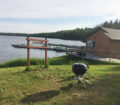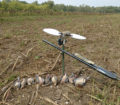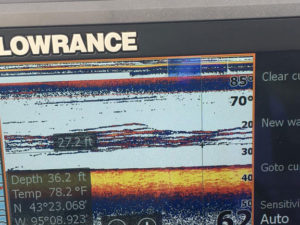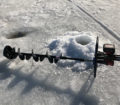By Captain Chad Loreth
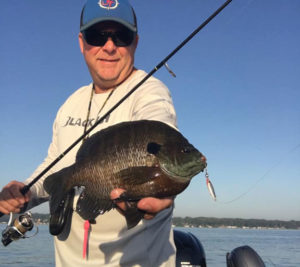 The heat of summer has arrived in the upper Midwest and there have been several days where it’s been down right hot! We all know what this is like living in NW Iowa where high temperatures combined with humidity make for some salty conditions to fish in by our standards, but in other parts of the country like Florida that is the norm. I for one don’t like hot weather every day of the year, but I do welcome when the weather gets like this for one reason- it’s time to go spoon feed some suspended and roaming schools of big Bluegills on West Okoboji Lake over deep water!
The heat of summer has arrived in the upper Midwest and there have been several days where it’s been down right hot! We all know what this is like living in NW Iowa where high temperatures combined with humidity make for some salty conditions to fish in by our standards, but in other parts of the country like Florida that is the norm. I for one don’t like hot weather every day of the year, but I do welcome when the weather gets like this for one reason- it’s time to go spoon feed some suspended and roaming schools of big Bluegills on West Okoboji Lake over deep water!
Early in the season Bluegills can be readily caught in the canals or around docks in shallow water on West Okoboji. In the spring a simple slip bobber set up is the most efficient way to target these fish. As the season transitions from spring to summer Bluegills begin to relocate to deeper water along deep weed edges or deep breaks where water temperature conditions are more comfortable for them and there is an abundance of food. As water temperatures continue to warm and the thermocline sets up in West Okoboji some of these schools of Bluegills, especially larger fish seek the solace of cooler water and relocate away from the weed lines and suspend over deep water adjacent to steep breaks. Large schools of Bluegills can be found suspended at 20-25 feet over 40 even 60 feet of water some days when it’s really hot. Spoon feeding these fish can be some of the most exciting fishing for anglers of all ages because of how good the fishing can be when targeting them.
When I talk spoon feeding, I’m not talking Gerber Baby Food green peas in a jar! I’m talking the Snare Spoon from Johnson Tackle! The Snare Spoon is the most efficient piece of tackle I have in the guide boat arsenal for targeting Bluegills in the summer, along with other species of fish as well. The Snare Spoon comes in a number of different weights but my 2 favorite are the 1/16 oz and 1/8 oz in different colors depending on water clarity. For the clear water on West Okoboji, I like Black and Silver, Blue and Nickel, Gold and Black and Purple Pearl. On lakes where the water is more stained like East Okoboji Lake, I like brighter colors like Firetiger, Chartreuse Tiger and Pink Glow tiger.
The Snare Spoon has a dropper chain and hook which makes it a very efficient bait when paired with live bait such as a Belgium Worm, Berkley Gulp Earthworms, Spikes, Wax worms or even a Minnow head. The dropper chain gives the bait great action when vertical jigged or casted. When I target suspended Bluegills in late summer we jig and also cast these baits for lots of rod bending action depending on what the schools of fish are doing.
To find these large schools of suspended Bluegills I start looking for fish along steep break lines adjacent to deep water. If you know West Okoboji Lake you know there isn’t a problem finding these areas when the average depth of the lake is 40’. Given the number of opportunities to find these schools of fish on West Okoboji, I will navigate up and down several break lines on the lake as they drop off into deep water and more often than not I will find schools of fish at 20-25’ adjacent to 30-40’ break line. It’s here away from the break and also away from the crowds of other boats where we find some of the largest Bluegills. Our guide customers get bent on large numbers of Bluegills and even other species of fish such as Yellow Bass, Crappies and even the occasional Smallmouth Bass or Fresh Water Drum, which I refer to as the “Iowa Halibut”!
Once we locate a school of Bluegills that look like willing participants suspended in the water column, we begin vertical jigging to gauge the attitude of the fish beneath us. If we get several hook ups right away and the fish stay beneath us I will stay spot locked over them until the bite slows. When the bite slows, I have customers cast out beyond the boat in different directions and let the spoons pendulum in back toward the boat on the retrieve. As the spoons begin the descent downward in the water column and back toward the boat more often than not we start catching fish again. When we cast I learn a few things before making a move if we hook up with fish. Did the fish just move out away from the boat a very short distance? Did they move just a few feet higher in the water column or did they move a little deeper? In many cases the fish just moved a few yards and are stilling biting aggressively so I re-position the boat over the school again and we continue to fish.
There are other days where I can tell from the first few drops if we are going to have to work a little harder to catch them. Usually what I’ll see is several hook ups right away then nothing. I’ll have customers cast and if we don’t connect then I reposition the boat just a few yards over the fish again and if we connect with several fish again then nothing, I know the schools are either afraid of the boat shadow on that particular day or they are just roaming out adjacent to the break and we can catch them, we just have to slowly keep moving with them. These are usually tougher days but the Snare Spoons keep us in the game because the spoons can be fished fast and efficiently through the water Column as we move.
Spoons and vertical jigging aren’t always the easiest way to target these fish for inexperienced anglers vs running a slip bobber, but many customers we have in the boat, even kids catch on very quickly. The key is giving them the right tool for the job even on tougher days. For us we like using a 6’6” or 7’0 Ultra Light rod, specifically the Panhandler from JT Outdoor Products and we spool the rods up with 6lb. Berkley Fireline Metered with a 6lb. Berkley Fluorocarbon leader. I like using a leader vs tying direct to the Fireline because it’s more efficient for me to re-tie several rods if we need to switch sizes and colors of Snare Spoons. The leader also isn’t as obvious to the fish vs tying direct because we are fishing in very clear water.
The reason I like putting a rod like the Panhandler in a guide customer’s hands is because from the first hook set the fun never ends, you see it in their face and they are going to be very successful with it given the sensitivity of the rod! The loading qualities of these Ultra -Light rods along with the sensitivity within the rod blank provide the ultimate fishing experience for even the youngest of anglers. The rods can also handle larger fish with ease which is another reason we like them. The rod sensitivity at the tip provides great visual bite indication for anglers of any experience level, but more importantly they can feel the bite in the handle easily, even if they did not see the bite.
With the Fireline being metered in a different color every 10’ it’s very easy for me to show customers how to determine depth of their bait in relation to where the fish are in the water column as seen on the fish finder. When you can teach someone a new way to target fish and they can visualize it before they actually do it, their chances for success are much higher because the learning curve is less, resulting in more hook ups. Lots of times on guide trips when we are fishing suspended Bluegills our customers are actually watching the graph as much as I do, looking at their rods as well and making depth adjustments on their own. They observe how deep and adjust accordingly after I’ve shown them how to fish the presentation, all possible because of the metered Fireline.
Some of the most exciting fishing trips I’ve ran as a professional fishing guide and licensed Captain have been in the heat of the summer on some of the most miserably hot days for fishing on West Okoboji Lake. If the fishing is hot, customers forget about the heat pretty quick. At the end of the day they catch a lot of fish, keep a few fish for the table, release some big Bluegills and know that the air conditioning will be cold when I drop them off at the dock. Did I say fishing is hard work?
Fishing suspended Bluegills who are willing to play ball means fast action and in the heat of the summer it can feel like you’re down on the Gulf of Mexico fishing the salt. The only difference is we aren’t chasing Redfish or Snapper! I will admit though after hot days of fishing with lots of action for customers, where I’m baiting hooks and unhooking fish in 95 degree temperatures I often see a mirage on the horizon. I’m still having a great time with customers, it’s snowing- a LOT, the lake is ice and snow covered and I can see myself ice fishing off the snowmobile hooked up with a fish. Soon my friends, soon!

